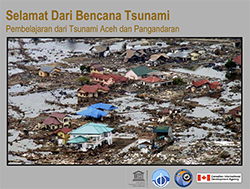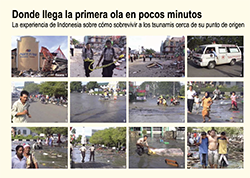
A strong atmospheric river will continue heavy rain over southern California through Friday. The heaviest rainfall is ongoing today in the Los Angeles Basin. Flash and urban flooding is possible. A prolonged heavy snowfall has begun over the Sierra Nevada Mountains and will continue through Friday. Travel will become increasingly difficult over the passes due to snow and strong winds. Read More >
Tsunami Awareness Materials > Where the First Wave Arrives in Minutes




This new booklet is intended for people who live, work, or vacation on shores worldwide where fast-arriving tsunamis may strike. The booklet draws survival lessons from eyewitness accounts of the tsunami of December 26, 2004 in Aceh, and of the July 17, 2006 tsunami on the south coast of Java.
The lessons have three main themes. First, several kinds of knowledge provide the earliest warnings of tsunami hazard, during the decades before a tsunami begins. Among warnings of a tsunami underway, earthquake shaking provides the most immediate natural signal to go to high ground. This reaction, in turn, is among nine survival tactics illustrated by the eyewitness accounts.
“Where the First Wave Arrives in Minutes” was compiled by Eko Yulianto, Fauzi Kusmayanto, Nandang Supriyatna, and Mohammad Dirhamsyah. It was adapted for international audiences by Brian F. Atwater, Eko Yulianto, and Ardito M. Kodijat, and it was produced by the Jakarta Tsunami Information Centre (JTIC). The booklet was printed in 2010 for UNESCO/IOC – NOAA International Tsunami Information Centre (ITIC) in Honolulu, Hawaii.
| Document | Format/Size |
| Bahasa Indonesia, 2009 | UNESDOC |
| English, 2010 | UNESDOC |
| Spanish, 2010 | UNESDOC |
| French, 2013 | UNESDOC |
| Arabic, 2010 | UNESDOC |